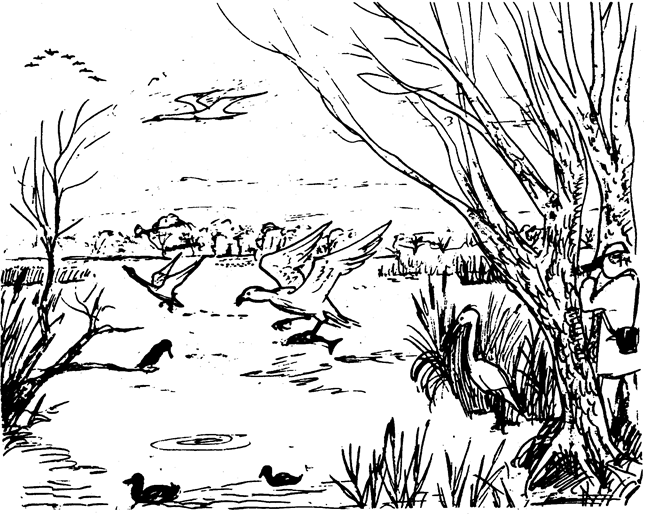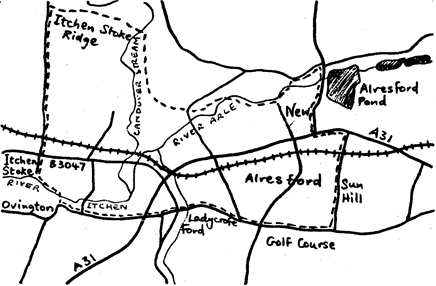Birds in Alresford Parish
by Jackie Carpenter

Alresford and its surroundings are alive with birds, and many interesting species can be seen with little effort. More serious attempts to observe birds in this area can lead to the discovery of quite uncommon species too.
In the town, a bird-table in the garden will attract perhaps four kinds of Tits, Reed Bunting, Chaffinches, Robins and even Woodpeckers. Song and Mistle Thrushes can be enjoyed as they sing from the tops of the trees in the churchyard and Warblers and Buntings are often seen along the railway cutting. Luring the summer, the Swifts scream lad through the streets on their way to their nesting sites in old houses and barns. Even rarities can occur in the town: there is a record of a Little Auk being picked up in Broad Street, disorientated and far from the sea.
Because Alresford is at the head of a river valley, it is surrounded by a host of watery habitats, each of which attracts birds. The many people, visitors and residents alike, who walk along the river from the Dean past the Fulling Mill to Ladywell Lane, must all enjoy the ducks on the river, Mallards and cross-breeds, the Swallows skimming the water, the Grey Wagtails and the occasional Kingfisher These birds bring an added movement and interest to the watery scene. More observant people may spot a Water Rail which, though often present, prefers to stay hidden. In the evening a flock of Canada Geese flies overhead, honking musically, up along this valley to land in Alresford Pond.
Alresford Pond is one of the few large stretches of inland water in Hampshire and is sought out by many kinds of water birds, especially in winter. The Pond is not a natural landmark; it was created in the twelfth century when the causeway (now the road to Old Alresford) was built to trap the stream. Now it is privately owned, and the owner is sympathetic to wildlife, so many species thrive in the Pond and its surroundings. Access round the Pond is restricted, which further increases its attractiveness to those wild birds that shun people. Nevertheless good views can be had over the Pond, both from the gardens of the Globe public house and from the causeway itself.
The habitats in the area of Alresford Pond are very varied. The Pond itself is really a lake and originally this was more than twice its present size. The area that used to be water-filled is now a marsh with extensive reed-beds. The silting-up is continuing in the present lake, so that it is no more than a few inches deep over a vast area, and mud is exposed at same seasons. The part of the lake nearest the road has not so far silted up and is very deep. There is an alder wood and areas of sallow and willow scrub around the pond. In each of these habitats there are different birds.
In the deep water near the road, Pochard and Tufted Ducks feed by diving right under. Male Tufted Ducks are black with white sides and an untidy hairstyle. Male Pochards are grey with a rusty brown head. The females of both are brown but are the same shape as their respective males. Between 80 and 100 of these diving ducks can be seen at the winter peak, and each year a small number of both species stay to breed. During June and July it is very pleasant to watch the ducklings learning to dive, usually without their parents. They seem too buoyant, and pop up out of the water like corks!
The majority of the ducks on Alresford Pond are dabblers and they thrive in the silted, weedy areas. Up to 200 Mallard are present at the peak and Teal can be equally numerous. A handful of Shovelers winter, and Shelduck, Garganey, Gadwall and Pintail occur infrequently. Wigeon, from the regular Itchen Valley flock, frequently drop in but they much prefer the water-meadows to the west of Alresford. In the summer, several pairs of Mallard breed, and one or two pairs of Teal. All these ducks are known as dabblers because of their feeding method; they do not dive but feed on the surface, head down and tail up. There are some ornamental ducks associated with the local hostelry, and numbers of Mute Swans and Canada Geese, but other wildfowl are rare, although Whooper Swan and White-Fronted Goose have been recorded.
Cormorants sometimes visit the Pond and are to be seen resting on the bare branches of the trees on the small island in the middle of the lake. Herons may be seen stalking their prey in the shallower parts of the Pond, and the Kingfisher often flashes past. Moorhens and Coots are always to be seen, the latter some-times reaching 250 during the winter months. Little Grebe is resident and Great Crested Grebe used to breed. Black-Headed Gulls and Common Gulls are regular and numerous, the latter in all seasons except summer. Black Terns often drop in on spring or autumn passage, and Common/Arctic Terns, Little Gulls and Kittiwakes are occasional visitors.
The only resident breeding waders are Snipe and Redshank, but the mud-patch that appears in the Pond in autumn attracts a good variety of other waders. There is a long list of those that have appeared from time to time, including Greenshank, Common Sandpiper, Wood Sandpiper, Green Sandpiper, Oystercatcher, Ringed Plover, Little Ringed Plover, Golden Plover, Curlew and Black-tailed Godwit. Finding an unexpected bird, even though it may be very common elsewhere, makes bird-watching very exciting.
The reed-beds and other marshy areas around the Lake provide breeding sites for many pairs of Reed Warblers, Sedge Warblers and Reed Buntings. Water Rail may breed, and Bitterns have been seen in recent years. Bearded Tits are also on record. Behind the reed-beds and along the sides of the incoming streams are areas of sallow and willow bushes. These are particularly good in summer and autumn because of their associated insect population on which birds such as Warblers feed, including the uncommon Cetti's Warbler. The alder swamp to the north is host to many birds throughout the year. Siskins and Redpolls feed on the alder fruits in winter, and in the summer, Flycatchers abound. Treecreepers and both species of Spotted Woodpecker seem particularly attracted to this wood.
There are several other smaller lakes in the Alresford area. At Arlebury Lake up to six pairs of Tufted Duck are known to have bred in the past, and in winter Tufted Duck, Pochard, Mallard and Teal occur in small numbers. Rarities hive included Garganey, Goosander and Dunlin, which is a small wader seldom seen inland.
A special watery habitat that occurs all around Alresford is water-cress beds. Many are in full production of this special salad vegetable, while others have fallen into decay. Although the habitat is so artificial it attracts all kinds of birds, perhaps the most notable being water Pipits which are seldom seen anywhere else around here. Green Sandpipers, Redshank, Yellow Wagtails (all dull yellow, with a shorter tail than Grey Wagtail), Water Rail and Kingfishers all seem to use the beds regularly. Unusual birds like Bar-Tailed Godwit, Jack Snipe, Ruff and Short-Eared Owl can occur. The Water Pipits, Wagtails and Waders like to run along the little concrete walls, constantly stopping to peck at the insects that abound at the beds.
The birds of Alresford are fascinating, and it is hoped that as many people as possible will come to value their wildness and beauty, and so take care not to thoughtlessly destroy the habitats and clean environment on which they depend.

The dotted line shows the route suggested for a walk round Alresford, on which fifty or more species of birds will probably be seen.
© Jackie Carpenter